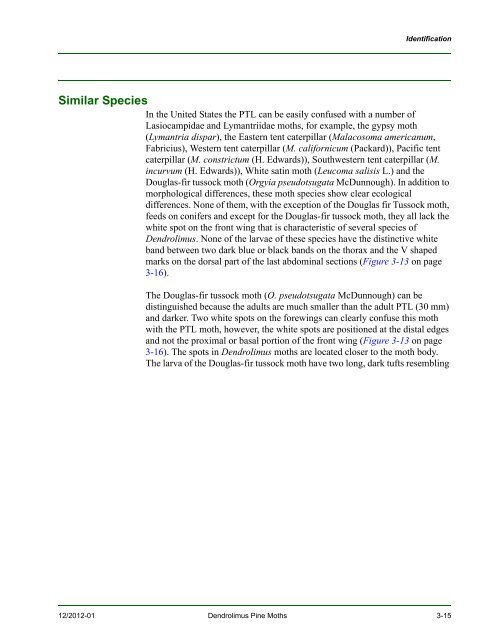New Pest Response Guidelines - aphis - US Department of Agriculture
New Pest Response Guidelines - aphis - US Department of Agriculture
New Pest Response Guidelines - aphis - US Department of Agriculture
You also want an ePaper? Increase the reach of your titles
YUMPU automatically turns print PDFs into web optimized ePapers that Google loves.
Identification<br />
Similar Species<br />
In the United States the PTL can be easily confused with a number <strong>of</strong><br />
Lasiocampidae and Lymantriidae moths, for example, the gypsy moth<br />
(Lymantria dispar), the Eastern tent caterpillar (Malacosoma americanum,<br />
Fabricius), Western tent caterpillar (M. californicum (Packard)), Pacific tent<br />
caterpillar (M. constrictum (H. Edwards)), Southwestern tent caterpillar (M.<br />
incurvum (H. Edwards)), White satin moth (Leucoma salisis L.) and the<br />
Douglas-fir tussock moth (Orgyia pseudotsugata McDunnough). In addition to<br />
morphological differences, these moth species show clear ecological<br />
differences. None <strong>of</strong> them, with the exception <strong>of</strong> the Douglas fir Tussock moth,<br />
feeds on conifers and except for the Douglas-fir tussock moth, they all lack the<br />
white spot on the front wing that is characteristic <strong>of</strong> several species <strong>of</strong><br />
Dendrolimus. None <strong>of</strong> the larvae <strong>of</strong> these species have the distinctive white<br />
band between two dark blue or black bands on the thorax and the V shaped<br />
marks on the dorsal part <strong>of</strong> the last abdominal sections (Figure 3-13 on page<br />
3-16).<br />
The Douglas-fir tussock moth (O. pseudotsugata McDunnough) can be<br />
distinguished because the adults are much smaller than the adult PTL (30 mm)<br />
and darker. Two white spots on the forewings can clearly confuse this moth<br />
with the PTL moth, however, the white spots are positioned at the distal edges<br />
and not the proximal or basal portion <strong>of</strong> the front wing (Figure 3-13 on page<br />
3-16). The spots in Dendrolimus moths are located closer to the moth body.<br />
The larva <strong>of</strong> the Douglas-fir tussock moth have two long, dark tufts resembling<br />
12/2012-01 Dendrolimus Pine Moths 3-15

















